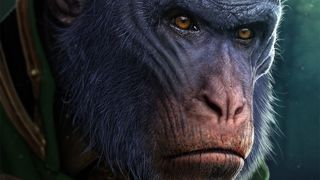How to create a cartoon character illustration in Maya
Discover how 3D artist Antony Ward created Serena the genie, from sketch to render.
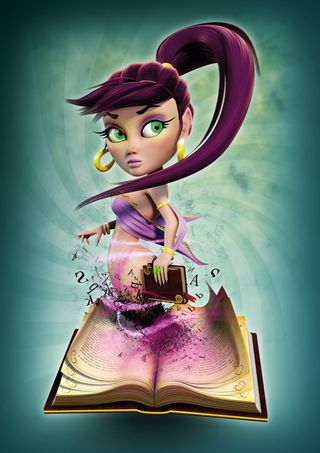
This tutorial reveals how I created the mystical genie, Serena. The aim of the project was to create an illustration that was bright, colourful and also had a hint of mystery about it. Why was Serena trapped inside this ancient tome, and who confined her to this papery prison?
Rather than focus on one area of her creation, we'll try to cover all the
bases. We'll begin by examining Serena's creation using subdivision surfaces as our main tool rather than sculpting, which is covered more frequently these days. Once all the elements are formed, we can then decide which areas we'll texture, and apply UV mapping.
Next, we'll light the scene and apply basic shaders, before we move onto the final render, where we examine render passes and batch rendering. In the final stages we take Serena into Photoshop, where we let our creativity explode as we adjust each render pass, add further details and polish each pixel to get the final image. See our Maya 2013 review for more on Maya.
- Download the source files for this tutorial here
01. Begin with primitives
There are a number of ways you can approach working on a character. You could begin with a cube, a polygon, or by sculpting virtual clay. All these methods have their advantages, but in this tutorial we're going to begin with primitives. When simplified, the human body can be broken down into basic geometric shapes, so it makes sense that we adopt the same foundations.
Create two cylinders - one for the left arm with eight sections around its axis, and another for the torso with 12 sections around its axis. These parts of the human anatomy are essentially cylindrical anyway, so it makes sense to begin with these shapes rather than trying to work with cubes and smoothing them later. Next, use a cube to form the foundations for the head and position half a sphere around the chest area - this will eventually form the character's breasts.
02. Mould into shape
With the primitives created you can now quickly adjust their shapes so they look a little more human. Applying a Smooth to the cube will transform it into a quad-based sphere, which will be easier to work with, and it won't have any poles, which could cause artefacts and pinching as we work.
When you're closer to a more natural shape, combine all the objects and weld each section to create a single, seamless mesh. It may be easier at this stage to halve your model first, so you don't do twice the work. You can then mirror it later.
With the elements combined into a single, seamless mesh we can then begin to work the vertices to create a more organic, feminine shape, and soften the whole appearance of the model. It's also at this stage that you can begin to smooth the model using the subdivision surfaces tools, or activate Maya's Smooth Mesh tool by pressing 3. This will give the model the appearance of having more geometry, even though it hasn't.
03. Add the hands
Adding the hands has been made easier because we created the arm with eight divisions around its axis, which gives us the optimal amount of geometry to work with.
Begin with three Bridge operations to fill the hole at the wrist, making three vertical quads. These can then be extruded to form the base for the first three fingers. Move back to the thumb area and extrude two more quads creating a third Extrude at the front of the new geometry to then form the fourth finger.
Add a final main extrusion at the base of the hand to form the thumb before reshaping the whole hand into a more acceptable shape. This may look basic, but it gives us the base topology to work upon.
Now you have the hands, you can move back and look at the model as a whole. Spend some time reworking and reshaping so it's anatomically correct, and don't be afraid to add a few more details as you work. It's also a good idea to have some anatomy reference at this stage.
04. Model the head
We don't have enough geometry to work with in the head yet so begin by adding a few edge loops around the face area. This will give you enough topology to start forming the nose and roughing out the major features of the face.
Continue these edge loops up and around the face and down to the chin. This will then enable you to create three holes - one for the mouth and two for the eyes. Add edge loops around these holes so you have more geometry to work with, allowing you to form the lips and eye lids. It's important at this stage to create two placeholder eyeballs to work around. This ensures the eye lids are the correct shape. It also important to retain the edge loops around these cavities because it will make creating facial expressions easier.
Finally,aswedidwiththebody,lookatthe head model as a whole and continue to shape it until you get the face you have in mind. All
that's left to do now is to add another hole at each side of the head and create the ears.
05. Define your pose
Once you're happy with the overall shape of Serena, you can start to think about posing her. One approach would be to insert joints into the mesh. This would then enable you to try different poses and possibly animate her, but you just need the one pose because this is an illustration, so you can use a simpler and quicker approach.
Simply select the vertices of the area you need to move - let's use the arms as an example - and press Insert to adjust the selection's pivot point, moving it to the shoulder. Now you can rotate around the new pivot, moving the arm in an almost natural way.
Activating Soft Selection (by pressing B) as you do this will add a subtle falloff to your selection, enabling you to affect the surrounding vertices slightly. Using this approach enables you to bend and pose the limbs easily because you can move the pivot point to each joint and rotate, almost as if you were manipulating skeletal joints.
The model will need to be tidied up again after you've posed her, but this will also give you the opportunity to build in any new muscles or surface details that would naturally occur as the body moves to this new position. It's also a good idea to add the basic props to the scene, such as the small book in the genie's hand, so you can get hand and finger poses spot on.
06. Add the scene props
The remaining props are constructed in much the same way as Serena was. Begin with simple shapes and adjust them to create the genie's clothing, her jewellery and the books. They are all basic shapes, so it shouldn't be too difficult to create them.
For the hair simply create one strip and duplicate it to form the rest. Attempting to create a full head of hair from a single model could be tricky, and problems will arise if you intend to use a texture to add detail later.
Make sure you keep the topology the same on each strip so you can transfer the UVs between them later, again saving you time.
At this stage feel free to build as much or as little as you like, but the more detail you can add the better.
07. Apply selective UV mapping
At this stage you need to take a moment and consider how you're going to colour your model. Will some areas need to be textured? Could some benefit from a basic shader? For this model, the genie's hair is the obvious place to start. She'll need more detail here.
Currently, the hair models don't have much topology to play with, which may make them tricky to UV map. When applying UVs Maya may struggle with a low-polygon object that has Smooth Mesh enabled, so apply a Smooth operation to the hair geometry, baking in the first subdivision. With that done, work on a single strand of hair and project the UVs down onto the model, following the Y axis.
Next, move into the UV Texture Editor and use the Unfold tools to unwrap and flatten the UV shell. First, constrain the operation horizontally and then vertically, but avoid using None initially. Now apply the Smooth to the rest of the hair sections. Because they now have the same topology, you can use the Transfer Attributes tool to copy the UVs from the initial section to the others. Work around the rest of the model, applying UVs to the sections you intend
to texture later.
08. Light and colour the scene
Now that Serena is posed and UV mapped, you can start to think about the final render and how the scene will be lit. Rendering now will give you a very basic, flat image but don't rush ahead. You need to start by defining the ambient lighting first, either with a simple Final Gather render, working from the camera's background colour, or from a more detailed HDRI map piped into the Indirect Lighting tab in the Render Settings. With the ambient lighting set, you can then go in and define a key light, which will give you a main light direction and your shadows, giving the image more depth.
You now have a nice render of a stone statue, so it's time to add some colour to the models and bring Serena to life. At this stage it's a good idea to use basic shaders to help set the tones, so a Blinn will work well for starters. As you can see, this will give you a nice start to the model, but to give the render more life you could also include a fake rim light effect to help push those details out from around the model.
Once you're happy with the colour on one element, repeat the process around the scene until everything else has a splash of colour. Now that you have a sense of how the colours are working together, you can think about applying textures.
09. Render out in passes
In theory you could render the scene as it is, then play around with it in Photoshop until you get the look you need. The problem with this approach is that you're limiting your options. Render passes enable you to output your main render along with various selected images. So as an example you could output the reflections separately so you can soften them, or adjust the amount reflected in post-production.
Imagine this for each and every element and you get the idea of just how much freedom you then have to play around with in Photoshop. In your Render Settings window go to the Passes tab. This is where you set the passes you need via the Create New Render Pass button. The default values for each pass are generally okay to go with. Once you've chosen the render passes you need, they will appear in the Scene Passes area.
All you need to do now is associate them with the current render layer
and then begin a Batch Render, because a normal render doesn't output all the passes. When the render process is complete, you'll end up with a folder full of various images representing the chosen render passes.
10. Final composition and tweaks
With all your render passes to hand you can now dive into Photoshop and start to layer them up. This is where you can be even more creative because you can basically do what you like with each pass. As a general rule, most will work well with a Screen blending mode, but shadow passes work best with the Subtract blending mode.
Not only can you adjust each render pass to get the perfect image, but because you're in Photoshop, you can use adjustment layers and layer masks to add more detail or emphasise the effects in just specific areas of the image.
You'll be surprised just how different a render can look when you take the time to polish it with the proper tools. Compare the base render with the final composite and you'll probably agree that the second is more appealing.
This article originally appeared in 3D World issue 165.
Liked this? Read these!
- Top free 3D models
- Best 3D movies of 2013
- Blender tutorials: ways to create cool effects

Thank you for reading 5 articles this month* Join now for unlimited access
Enjoy your first month for just £1 / $1 / €1
*Read 5 free articles per month without a subscription

Join now for unlimited access
Try first month for just £1 / $1 / €1
Get the Creative Bloq Newsletter
Daily design news, reviews, how-tos and more, as picked by the editors.
The Creative Bloq team is made up of a group of design fans, and has changed and evolved since Creative Bloq began back in 2012. The current website team consists of eight full-time members of staff: Editor Georgia Coggan, Deputy Editor Rosie Hilder, Ecommerce Editor Beren Neale, Senior News Editor Daniel Piper, Editor, Digital Art and 3D Ian Dean, Tech Reviews Editor Erlingur Einarsson and Ecommerce Writer Beth Nicholls and Staff Writer Natalie Fear, as well as a roster of freelancers from around the world. The 3D World and ImagineFX magazine teams also pitch in, ensuring that content from 3D World and ImagineFX is represented on Creative Bloq.
Related articles
-
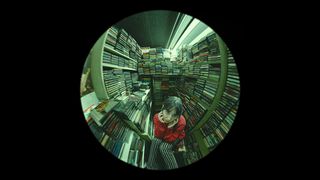
-
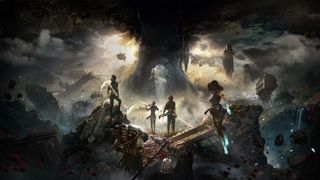
-
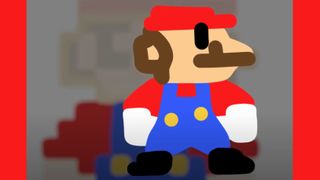
-
